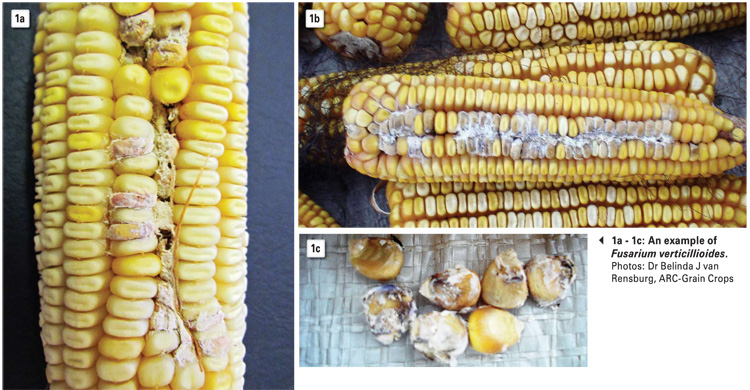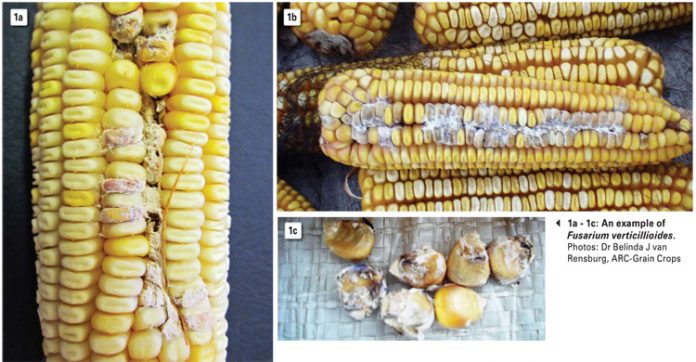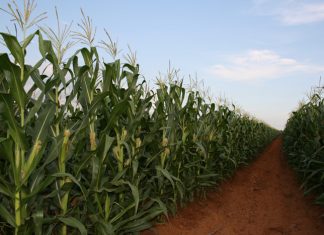June 2017
PROF PIET STEYN, consultant to the Maize Trust
In South Africa, the supply of high quality, healthy maize is a national priority since maize represents the staple food of many South Africans. Moreover, maize is of great importance as feedstock in the animal and poultry industry.
In nature most cereal grains, oil seeds, tree nuts, fruits and dehydrated fruits are susceptible to contamination by mycotoxin-producing fungi during the pre-harvest (production), post-harvest (storage) and processing stages.
These fungi have the ability to produce some hazardous toxins, called mycotoxins such as the fumonisins, aflatoxins, zearalenone, ochratoxins, trichothecenes (deoxynivalenol [DON] and nivalenol [NIV]) and diplodiatoxins (diplonine).
Fortunately, the hepatocarcinogenic aflatoxins occur extremely rarely on South African commercial maize, reducing their significance locally as a potential health threat. The fumonisins, mainly produced by Fusarium verticillioides and Fusarium proliferatum, represent the most important mycotoxin threat to the local maize industry.
Mycotoxins pose an enormous threat to the international trade in foods and feeds. Post-harvest losses in the developing world, in particular, are severe because of inadequate storage facilities and the consequent poor quality of the produce. It is claimed that approximately 60% of Africa’s grain supplies are at risk owing to fungal contamination and mycotoxin formation, thereby contributing to food insecurity.
The more than 300 known mycotoxins comprise small-molecularweight compounds, derived from the secondary metabolism of several fungi, including members of the genera Aspergillus, Penicillium, Fusarium, Claviceps, Stenocarpella and Alternaria.
These compounds are thermally stable and cannot be eliminated during food processing. Mycotoxins induce powerful and dissimilar biological effects in humans and animals. Some are carcinogenic (aflatoxins, ochratoxins and fumonisins), mutagenic (aflatoxins and sterigmatocystin), teratogenic (ochratoxins), oestrogenic (zearalenone), haemorrhagic (trichothecenes), immunotoxic (aflatoxins and ochratoxins), nephrotoxic (ochratoxins), hepatotoxic (aflatoxins, ochratoxins and phomopsins), dermatoxic (trichothecenes) and neurotoxic (ergotoxins, penitrems, lolitrems and paxilline), whereas others display antitumor, cytotoxic and antimicrobial properties.
The global health threat of mycotoxins to mankind is based on well documented human mycotoxicoses such as ergotism, alimentary toxic aleukia in Russia, acute aflatoxicoses in South and East Asia, and human primary liver cancer in Africa and South East Asia.
The fumonisins are implicated in the aetiology of the high incidence of oesophageal cancer among the inhabitants of the former Trans kei region of South Africa, China and Iran and with clusters of birth defects, i.e. neural tube defects such as anencephaly and spina bifida, occurring in different parts of the world such as on the Texas- Mexico border.
Although the role of mycotoxins in diseases among domestic animals is better established, diagnosis of the mycotoxicosis is extremely difficult owing to the numerous pharmacological effects of the causative toxins, for example aflatoxins (Turkey-X disease), fumonisins (leukoencephalomalacia in horses and pulmonary oedema in swine), ochratoxins (nephropathy in swine [Danish porcine nephropathy]), phomopsin A (lupinosis in sheep), sporidesmin A (facial eczema in sheep) and zearalenone (hyperoestrogenism, vulvovaginitis and abortion in swine). Outbreaks of diplodiosis amongst farm animals are linked to feeds contaminated with Stenocarpella maydis.
Since the discovery of aflatoxins during the 1960s, an increasing number of countries have legislated maximum tolerated levels for an increasing number of mycotoxins with the aim of protecting both human and animal populations from the harmful effects of mycotoxin exposure.
Aflatoxin remains the most widely legislated mycotoxin. At least 99 countries have regulatory limits for AFB1 or the sum of AFB1, AFB2, AFG1 and AFG2 in food and/or feed. Levels for DON, fumonisin B1 and fumonisin B2 are regulated in South Africa since 2016.
Mycotoxin research requires a multi-faceted approach, involving the following expertise: Epidemiology, human and veterinary toxicology, human and animal nutrition, fungal taxonomy and biology, biochemistry, molecular biology, genetics, structural organic chemistry, synthetic organic chemistry, physical chemistry, analytical chemistry, food analysis, plant breeding, modelling expertise, risk assessment, management of mycotoxin-producing fungi, and regulatory expertise.
In 2009, on the invitation of the Maize Forum and the Maize Trust management, I approached a number of leading mycotoxin researchers from CSIR Biosciences, PROMEC Unit of the MRC, ARCGrain Crops and universities to develop a strategy, namely vision, mission and objectives for mycotoxin research.
The mycotoxin research is currently co-ordinated by the Mycotoxin Research Review Panel (MRRP), comprising senior scientists from the ARC-Grain Crops, SA Grain Laboratory (SAGL), SANSOR, Stellenbosch University (SU), Cape Peninsula University of Technology (CPUT) and Mr Leon du Plessis (Maize Trust, ex officio).
Vision for mycotoxin research at the Maize Forum/Maize Trust
To enable leading mycotoxin research for the maize industry in South Africa.
Mission for mycotoxin research at the Maize Forum/Maize Trust
It is the mission of the Maize Forum and the Maize Trust to have world-class mycotoxin research undertaken at South African universities and research institutions in order to ensure that safe maize is supplied to the food and animal feed industries, consumers and export markets.


Main objectives for mycotoxin research at the Maize Forum/Maize Trust
- To support the establishment of the magnitude of mycotoxin contamination of maize during the stages of its production, storage, and processing in South Africa.
- To support the regular monitoring of the occurrence of the fumonisins, aflatoxins, zearalenone, and trichothecenes (deoxynivalenol, DON, and nivalenol) in locally produced and imported maize.
- To support the determination of the factors which contribute to mycotoxin contamination during the production (pre-harvest), storage (post-harvest) and processing of maize.
- To support the development of practical, affordable and environmentally sound methods to manage toxigenic fungi in maize, with particular emphasis on the introduction of resistance in local maize cultivars.
- To support the development of sound mycotoxin risk management practices in the maize supply chain to ensure the delivery of safe products to the consumer.
The Maize Trust mycotoxin research benefits from the rapid multi-mycotoxin analytical technology available at the SAGL, Pretoria and at the Central Analytical Facilities of SU, both equipped with UPLC’s connected to Quattro mass spectroscopy systems.
The characterisation and quantitation of the mycotoxins involved in diplodiosis, however, still remain a challenge. In this regard, researchers at the University of Pretoria are equipped with hyphenated HPLC – Solid Phase Extraction – 500 MHz Bruker Nuclear Magnetic resonance cryoprobe, which allows differentiation between known and unknown compounds as well as establishing full constitutions directly from the crude extract with a minimum amount of material.
The Maize Trust strongly advocates interinstitutional and interdisciplinary research, as a prerequisite for excellent mycotoxin research. A management system for annually selecting and evaluating a number of research projects, based on peer review, has been established.
Early in the year, the management of the Maize Trust invites South African researchers to submit concept research proposals aligned to the main objectives listed above. These research proposals are assessed by the mycotoxin research co-ordinator and sent for peer review to South African and international peers (scientists from the USA, Canada, UK, Europe, Africa, Russia, China and Japan).
The members of the MRRP examine the reviewers’ reports and select a number of the project proposals to be enhanced and submitted to the Maize Trust as comprehensive research proposals (CRPs). The successful authors of the CRPs are invited to present their proposals at a meeting of the MRRP held in August.
Based on all the information, the MRRP advises the Steering Committee of the Maize Forum on the most commendable projects for funding. The final decisions on the funding of the CRPs are taken by the Board of the Maize Trust, based on the recommendations of the MRRP and the Steering Committee.
The research outputs of the various research groups are actively monitored as a prerequisite for on-going investment in the projects. The participating scientists are encouraged to submit their research findings for publication in peer-reviewed journals, and industry directed publications, to transfer information to the farming community and to contribute to human capital development by training postgraduate students up to the doctoral level.
In South Africa, world-class mycotoxin research has been done over many years at the CSIR and the MRC.
Over the past few years, research was sponsored at the ARC/Grain Crops, ARC/OVI, CPUT (former PROMEC Unit of the MRC), SAGL, SU, UCT, UP, TUT and UKZN.
The research outputs contribute to the national and international standing of mycotoxin research in South Africa, with the credo: Local relevance at the standard of international excellence.
References
Alberts, JF, Van Zyl, WH and Gelderblom, WCA. 2016. Biologically based methods for control of fumonisin-producing Fusarium species and reduction of the fumonisins. Frontiers in Microbiology. http://doi.org/10.3389/fmicb.2016.00548. Beukes, I, Rose, LJ, Shephard, GS, Flett, BC and Viljoen, A. 2017. Mycotoxigenic Fusarium species associated with grain crops in South Africa. South African Journal of Science. http://dx.doi.org/10.17159/sajs.2017/20160121. Janse van Rensburg, B, McLaren, NW, Flett, BC and Schoeman, A. 2015. Fumonisin producing Fusarium spp. and fumonisin contamination in commercial South African maize. European Journal of Plant Pathology 141, 491 – 504.
Marasas, WFO, Gelderblom, WCA, Shephard, GS and Vismer, HF. 2012. Mycotoxicological research in South Africa 1910 – 2011. World Mycotoxin Journal 5, 89 – 102. Steyn, PS, Gelderblom, WCA, Shephard, GS and Van Heerden, FR. 2009. Mycotoxins with a special focus on aflatoxins, ochratoxins and fumonisins. General and Applied Toxicology, Third Edition (Eds. Ballantyne, B, Marrs, TC, Syversen, T), John Wiley and Sons, 6, 3 467 – 3 527.
Publication: June 2017
Section: On farm level


















